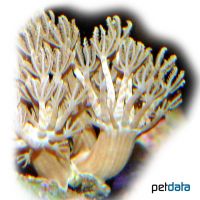Pulsing Xenia (Xenia sp.)
| Pulsing Xenia Xenia sp. | |
|---|---|
| Name | Pulsing Xenia |
| Name Lat. | Xenia sp. |
| Family | Pulse Corals |
| Family lat. | Xeniidae |
| Order | Soft Corals |
| Order lat. | Alcyonacea |
| Origin | Indo-Pacific |
| Diet | Autotrophic |
| pH | 8.1-8.4 |
| Hardness | 8-10 °KH |
| Lighting | Medium-high |
| Current | Moderate |
| Behavior | Peaceful |
| Keeping | Colony |
| Care Level | Moderate |
| Life Span | N/A |
| Protection | No |
| Metric Units | |
| Size | 8 cm |
| Temperature | 22-28 °C |
| Salinity | 33-36 ‰ |
| Aquarium | 200 l |
| US Units | |
| Size | 3" |
| Temperature | 72-82 °F |
| Salinity | 1.020-1.025 sg |
| Aquarium | 50 gal |
Distribution and habitat
Xenia spp. belongs to the group of soft corals. This non-reef-building coral is widely distributed in the Red Sea, tropical Indian Ocean and Pacific Ocean. They usually live in large colonies in the well-flowed, often turbid shallow waters of lagoons and on vertical reef slopes protected from strong surf. According to their species and origin they occur in different colors and growth forms. The picture shows a Xenia umbellata
Maintenance
They should be positioned in a place with high to medium light intensity and moderate to strong, alternating current. Only high-calcium, heavy metal-free substrates should be used as substrate. Filters, skimmers and heaters are necessary to ensure water quality, as well as pumps to simulate tides, swells and bottom currents. It is recommended that live stones be used to set up the aquarium. The bacteria living in the porous stones act as a biological filter. The lighting must correspond to the species-appropriate day-night rhythm of the animals
| Salinity: 33-36 ‰ | pH value: 8.1-8.4 |
| Carbonate hardness: 8-10 °KH | Nitrate content: 2-8 mg/l |
| calcium content: 420-450 mg/l | Nitrite content: 0.0-0.05 mg/l |
| Magnesium content: 1.250-1.350 mg/l | phosphate content: 0.01-0.1 mg/l |
Regular addition of trace elements, especially iodine, is recommended. For salinity, an average value should be aimed for, which may only vary slightly by +/- 0.5 ‰. Ammonia and ammonium must not be measurable. Special attention shall be paid to consistently good water quality and water values.
Diet
Zooxanthellae, which are unicellular symbiotic algae, live in their tissue and provide them with assimilation products of their photosynthesis (high light requirement). The zooxanthellae promote growth and provide their main food. For this purpose, plankton and small particles are collected from the water current. Thus, in addition to the food produced in the aquarium during fish feeding (mysis, krill, Artemia, etc.), commercial supplementary food in the form of phyto- and zooplankton should be offered once a week. Regular feeding promotes good health.
Behaviour and compatibility
They usually live in larger colonies and should not be kept with fish that regard their polyps as food (e.g. angelfish or butterflyfish). They are well tolerated with other corals, but sufficient distance from cnidarians must be maintained. These fast growing corals may overgrow or shade other corals.
Reproduction and breeding
In nature, reproduction is sexual via marine larval stages. In the aquarium they can be well reproduced by division. Successful sexual reproduction in the aquarium has not been reported so far.
Important
Xenids can migrate in the aquarium, usually to just below the surface to get sufficient light. The additional illumination with actinic light (short-wave, violet-blue light) is very beneficial for their growth (zooxanthellae). They develop particularly well in the company of leather corals of the Sarcophyton family.
They can pump or pulsate, although the reason for this has not yet been scientifically determined. However, there is a direct correlation to light intensity, lighting duration, water quality and nutrient concentration. A cessation of pumping is not necessarily a sign of poor health. If individual polyps turn dark brown or suddenly shrink, they should be removed from the aquarium immediately to prevent colony death. Addition of iodine and suspension of skimming can often be helpful
New animals to be introduced must be acclimated slowly to the water in the aquarium. If different species are kept together, care should be taken to match fish and invertebrates in terms of water quality and temperature requirements and social behavior, and to ensure that the setup meets the ecological needs of all species kept together
Further literature can be found in your pet store.
References
Text: Werner Winter; Image: petdata
Source: ENGELMANN & LANGE (2011): Zootierhaltung - Tiere in menschlicher Obhut: Wirbellose, Verlag Harri Deutsch; FOSSÁ & NILSEN (1995): Korallenriff-Aquarium Bd. 4, Birgit Schmettkamp Verlag
